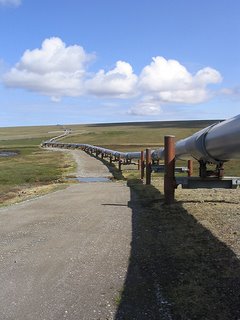Trans-Alaskan Pipeline
SUMMARY 
The Trans-Alaska pipeline is 800 miles long and was constructed in 1977. The pipeline is designed to withstand many environmental and geological occurrences, such as frost and earthquakes. The Trans-Alaska Pipeline System was designed and constructed to move oil from the North Slope of Alaska to the northern most ice- free port- Valdez, Alaska. During the oil’s journey south it crosses numerous geological faults, which expose the pipe to dangers of shifting foundations or even rupturing. I will take a look at the importance of the role the pipe serves in our current energy needs and for fun I will then discuss some of the interesting design aspects involved to overcome the environmental challenges.
THE PIPELINE’S IMPORTANT ROLE IN OUR ENERGY DEMAND
Pipeline elsewhere, is a major U.S. oil pipeline connecting oil fields in northern Alaska to a sea port where the oil can be shipped to the Lower 48 states for refining. Since its completion in 1977, the pipeline has transported over 15 billion barrels of oil, that is an average of about 1.93 billion barrels a year. Given that the U.S. consumes approximately 20 billion barrels of oil a year the Alaskan oil is but a small fraction to quench our demand. The oil from the northern oil fields is stored in sstorage tanks in Valdez until tanker ships transport the oil to refineries. There are 18 storage tanks with total storage capacity of 9.1 million barrels total. The Alaska North Slope (ANS) oil field functions on the principle that U.S. oil be used domestically, and remain available for consumption in the U.S. as a matter of energy security, but about 7% of crude oil production from the ANS is currently exported to South Korea, Japan, and China. When the pipeline was constructed congress put a ban on the export of the oil that was to flow through it. That ban has recently been overturned as we now export 7% of the oil. A June 1994 Department of Energy (DOE) study, Exporting Alaskan North Slope Crude Oil-Benefits and Costs, found that exporting Alaska crude would increase producer receipts for both California and Alaska oil. The increased producer receipts would be the result of transportation savings realized by avoiding a trip through the Panama Canal.

The Trans-Alaska pipeline is 800 miles long and was constructed in 1977. The pipeline is designed to withstand many environmental and geological occurrences, such as frost and earthquakes. The Trans-Alaska Pipeline System was designed and constructed to move oil from the North Slope of Alaska to the northern most ice- free port- Valdez, Alaska. During the oil’s journey south it crosses numerous geological faults, which expose the pipe to dangers of shifting foundations or even rupturing. I will take a look at the importance of the role the pipe serves in our current energy needs and for fun I will then discuss some of the interesting design aspects involved to overcome the environmental challenges.
THE PIPELINE’S IMPORTANT ROLE IN OUR ENERGY DEMAND
Pipeline elsewhere, is a major U.S. oil pipeline connecting oil fields in northern Alaska to a sea port where the oil can be shipped to the Lower 48 states for refining. Since its completion in 1977, the pipeline has transported over 15 billion barrels of oil, that is an average of about 1.93 billion barrels a year. Given that the U.S. consumes approximately 20 billion barrels of oil a year the Alaskan oil is but a small fraction to quench our demand. The oil from the northern oil fields is stored in sstorage tanks in Valdez until tanker ships transport the oil to refineries. There are 18 storage tanks with total storage capacity of 9.1 million barrels total. The Alaska North Slope (ANS) oil field functions on the principle that U.S. oil be used domestically, and remain available for consumption in the U.S. as a matter of energy security, but about 7% of crude oil production from the ANS is currently exported to South Korea, Japan, and China. When the pipeline was constructed congress put a ban on the export of the oil that was to flow through it. That ban has recently been overturned as we now export 7% of the oil. A June 1994 Department of Energy (DOE) study, Exporting Alaskan North Slope Crude Oil-Benefits and Costs, found that exporting Alaska crude would increase producer receipts for both California and Alaska oil. The increased producer receipts would be the result of transportation savings realized by avoiding a trip through the Panama Canal.
CONCLUSION
It can then be concluded that the pipeline plays a vital role in our energy demand and also in the energy demands of a few other countries. The pipeline is just a small part of the puzzle when it comes to the U.S. oil imports but it plays a vital role in energy security. During the Arab oil embargo of 1973 there was a great sense of need for such energy security.

0 Comments:
Post a Comment
<< Home